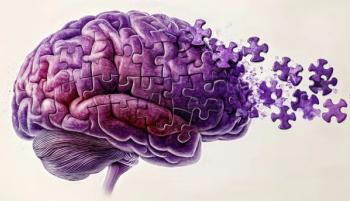
Identifying and Managing Suffering in Terminal Dementia
How do you know whether a patient with end-stage dementia is experiencing pain or suffering when the patient has lost the ability to communicate verbally? Experts say a clinician should have a high index of suspicion that a patient with end-stage dementia is experiencing pain or suffering.
How do you know whether a patient with end-stage dementia is experiencing pain or suffering when the patient has lost the ability to communicate verbally? Experts say a clinician should have a high index of suspicion that a patient with end-stage dementia is experiencing pain or suffering.
About 60% of the general population older than 75 years has some degree of pain, most commonly caused by arthritis, headache, diabetes, or cancer, according to R. Sean Morrison, MD, director of the National Palliative Care Research Center, Brookdale Department of Geriatrics and Adult Development, Mount Sinai School of Medicine, New York City. This is also true for patients with dementia, most of whom are older.
"In Alzheimer disease and other dementing illnesses, data to date suggest that although people have lost the ability to communicate, they still have pain and suffering, usually due to comorbidities or new diseases," he said. Also, medical interventions as simple as a blood test can be painful experiences for severely demented patients who may be unaware of the procedures. Even moving a patient with advanced arthritis from a bed to a chair can cause pain, he said.
"Nondemented people can tell you about pain, and then you can intervene," Morrison commented. But demented people are dependent on their caregivers to recognize their pain and suffering. This can be difficult because there is no lab test for pain."
Morrison's approach is to assume that patients with dementia experience some pain. If they can communicate to some extent, he asks them simple, repetitive questions about whether they are suffering. He advises physicians to observe end-stage patients who cannot talk for pain behaviors, such as grimacing, resisting movement, agitation, and restlessness.
Patients with dementia who experience agitation and restlessness are frequently treated with tranquilizers because clinicians assume that these symptoms are related to dementia. In fact, pain can cause both agitation and restlessness. Before giving the patient a tranquilizer, a trial of analgesics should be attempted to see if the agitation or restlessness resolves, Morrison suggested. Other behaviors that suggest chronic pain include somnolence, disturbance of the sleep-wake cycle, and depression. "Excessive daytime sleepiness and sleep-wake disturbances and depression often occur in people with chronic pain. It is easy to miss this," Morrison said. "Always keep in mind that pain can cause symptoms we don't think of as pain symptoms per se," he cautioned.
MEASURING PAIN
Patients with moderate levels of dementia can still respond to traditional pain scales, such as the 10-point pain scale, according to Kenneth Brummel-Smith, MD, Charlotte Edwards Maguire Professor and chair of the Department of Geriatrics, Florida State University College of Medicine, Tallahassee. A variety of pain scales that are visualized by the patient may be useful in more severe dementia. "It depends on the severity of dementia and the patient's capacities," he commented. For end-stage patients, Brummel-Smith relies on the Hurley Pain Scale,1 which takes 5 to 15 minutes to administer and tests for a variety of pain behaviors. He also cited the Mini-Suffering State Examination (MSSE)2 as a useful tool.
"As the elderly population grows exponentially, we will see more pain scales being developed, Brummel-Smith said. "One study showed that caregivers are especially attuned to pain in patients with end-stage dementia. The bottom line is to use pain scales and informants." He noted that pain can actually worsen cognitive impairment. Even if cognition is impaired, "relief of pain can help whatever cognition is left."
Bechor Aminoff, MD, member of the Department of Geriatric Medicine and Memory Clinic at Sheba Medical Center in Tel Hashomer, Israel, monitored 71 patients with advanced dementia and confirmed that the MSSE is a reliable tool for evaluating the severity of a patient's condition and his or her level of suffering. The MSSE lists 10 items related to the patient's characteristics as well as the perception of his condition by the medical staff and the patient's family (Table).
Aminoff said that end-stage dementia patients may live for many years. He believes that the neurologist should determine whether the patient is in the end stages of dementia and use the MSSE to evaluate suffering level and survival potential for these patients. "We cannot change the cognitive or functional decline of these patients, but we can diagnose and measure the level of suffering and treat the suffering until the patient's demise," Aminoff stated.
Most end-stage dementia patients eventually are institutionalized. In the institutional setting, the Geriatric Rehabilitation and Restorative Assessment System (GRRAS)3 is used and consists of 3 separate but related instruments: the Geriatric Level of Dysfunction Scale, which assesses the intensity, frequency, and duration of 19 behavioral disturbances that can interfere with activities of daily living; the Multidimensional Pain and Illness Inventory, which measures the effects of pain and other noxious symptoms (eg, dizziness, shortness of breath, nausea) on quality of life; and the Psychosocial Resistance to Activities of Daily Living Index, which assesses the patient's level of cooperation and independence across 8 activities of daily living critical to geriatric rehabilitation.
Andrew Clifford, PhD, a geriatric psychologist and Clinical Research Director of Mind-Body Wellness in Dallas, is a coauthor of the GRRAS. He explained that the GRRAS uses family and health care provider information and observations of the patient to make assessments during the final stages of dementia. The GRRAS also utilizes the Brief Cognitive Rating Scale,4 developed by Barry Reisberg, MD, professor in the Department of Psychiatry at New York University School of Medicine, and the Functional Assessment Staging Tool to identify and stage patients.5
Persons with dementia undergo "retrogenesis," which means that they go through the cognitive stages of maturation in reverse as they continue to deteriorate. Persons with severe dementia have the problem-solving ability of a very young child, Clifford commented. In the final stages, vocabulary may be limited to as few as 2 words.
Clifford said that suffering is often reflected in nonverbal behaviors such as refusing to eat and/or participate in activities, staying in bed, and acting out aggressively. In general, the failure to thrive syndrome may be a sign of pain or depression. A trial of antidepressants and behavioral therapy can be useful in patients with dementia who exhibit these behaviors. If they improve after a 3-month trial, Clifford recommends maintenance therapy; if they don't improve, palliative care is then pursued.
INTERVENTIONS
If pain is suspected in someone with advanced dementia, the physician should try to identify the source of pain, Morrison said. This entails a thorough physical exam, including looking for pressure ulcers, arthritic joints, neuropathy in persons with diabetes, and bone pain (which can sometimes be related to undiagnosed, metastatic cancer). If pain is suspected, a trial of acetaminophen or NSAIDs should be attempted. Morrison said that these drugs are easy to stop if the pain symptoms don't resolve.
"End-stage dementia is a disease for which there is no cure. At a bare minimum, the least we can do is make sure our patients are comfortable," he stated.
Brummel-Smith said that in addition to pain, patients with end-stage dementia experience other types of suffering. Loneliness, scary noises, interruptions in the normal sleep-wake cycle, and adverse effects of medications can cause suffering. Psychotropics can cause delusions, and other medications can interfere with sleep. Adverse effects of medications should be considered if the patient seems to be suffering.
Hospice can be helpful for advanced dementia patients who are suffering, but the hospice benefit is covered by insurance only for 6 months and patients with end-stage dementia may live for several years. Loss of the swallowing reflex in advanced dementia is a sign of brain deterioration, Brummel-Smith noted. He advised against ordering a feeding tube in this circumstance, because the tube keeps the patient alive and allows progressive neurologic deterioration to occur. Some families have a great deal of trouble letting the patient die, but it is important to follow the patient's wishes, which were hopefully determined at a time when cognition was intact.
"People avoid discussing death, but it is especially important to find out how a patient with dementia wants his life to end while he is still able to communicate," said Brummel-Smith. "Some people who will eventually have end-stage dementia do not want to be totally dependent and live in a nursing home. When those people become institutionalized with advanced dementia, the nursing home provider staff should not treat medical complications such as pneumonia." Brummel-Smith asserted that physicians must have the courage to discuss dying with the patient and family and to get the patient to fill out a Living Will. "As a physician, one is obligated to follow the directions of the patient and stand up against the family, if necessary," he said.
REFERENCES1. Hurley AC, Volicer BJ, Hanrahan PA, et al. Assessment of discomfort in advanced Alzheimer patients. Res Nurs Health. 1992;15:369-377.
2. Aminoff BZ, Purits E, Noy S, Adunsky A. Measuring the suffering of end-stage dementia: reliability and validity of the Mini-Suffering State Examination. Arch Gerontol Geriatr. 2004;38:123-130.
3. Clifford PA, Cipher DJ. The Geriatric Multidimensional Pain and Illness Inventory. Clin Gerontologist. 2005;28:45-61.
4. Brief Cognitive Rating Scale. Geriatric Resources Web site. Available at:
5. Functional Assessment Staging Tool. Geriatric Resources Web site. Available at: http://www.geriatric-resources.com/html/fast.html. Accessed October 12, 2006.
Newsletter
Receive trusted psychiatric news, expert analysis, and clinical insights — subscribe today to support your practice and your patients.

















